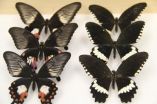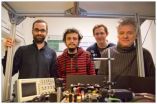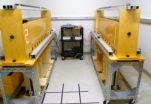(Press-News.org) TALLAHASSEE, Fla. — Prenatal exposure to nicotine could manifest as attention deficit hyperactivity disorder in children born a generation later, according to a new study by Florida State University College of Medicine researchers.
Professors Pradeep G. Bhide and Jinmin Zhu have found evidence that ADHD associated with nicotine can be passed across generations. In other words, your child's ADHD might be an environmentally induced health condition inherited from your grandmother, who may have smoked cigarettes during pregnancy a long time ago. And the fact that you never smoked may be irrelevant for your child's ADHD.
The researchers' findings are published in the current issue of The Journal of Neuroscience.
"What our research and other people's research is showing is that some of the changes in your genome — whether induced by drugs or by experience — may be permanent and you will transmit that to your offspring," said Bhide, chair of developmental neuroscience and director of the Center for Brain Repair at the College of Medicine.
Bhide and Zhu, assistant professor of biomedical sciences, used a mouse model to test the hypothesis that hyperactivity induced by prenatal nicotine exposure is transmitted from one generation to the next. Their data demonstrated that there is a transgenerational transmission via the maternal, but not the paternal, line of descent.
"Genes are constantly changing. Some are silenced and others are expressed, and that happens not only by hereditary mechanisms, but because of something in the environment or because of what we eat or what we see or what we hear," Bhide said. "So the genetic information that is transmitted to your offspring is qualitatively different than the information you got from your parents. This is how things change over time in the population."
Building on recent discoveries about how things like stress, fear or hormonal imbalance in one individual can be passed along to the next generation, Bhide and Zhu were curious about a proven link between prenatal nicotine exposure and hyperactivity in mice.
Their work at the Center for Brain Repair has included extensive research around ADHD, a neurobehavioral disorder affecting about 10 percent of children and 5 percent of adults in the United States. Researchers have struggled to produce a definitive scientific explanation for a spike in ADHD diagnoses in the last few decades.
"Some reports show up to a 40 percent increase in cases of ADHD — in one generation, basically," Bhide said. "It cannot be because a mutation occurred; it takes several generations for that to happen."
One possible contributing factor, though unproven, is that the current spike in ADHD cases correlates in some manner to an increase in the number of women who smoked during pregnancy as cigarettes became fashionable in the United States around the time of World War II and in the decades that followed.
"Other research has shown a very high correlation between heavy smoking during pregnancy and the incidence of kids with ADHD," Bhide said.
"What's important about our study is that we are seeing that changes occurring in my grandparents' genome because of smoking during pregnancy are being passed to my child. So if my child had ADHD it might not matter that I did not have a disposition or that I never smoked."
Bhide cautions that the work, though conclusive, is based on a study in mice, which have served as a proxy for human phenotypes.
"It's not that every child born to a mother who smokes has ADHD, and it also isn't true that every person with ADHD will transmit the genetic material responsible," he said.
"But our work has opened up new possibilities. The next question is how does transmission to future generations happen? What is the mechanism? And the second question is, if the individual is treated successfully would that stop the transmission to future generations?"
INFORMATION:
In addition to Zhu and Bhide, the paper's co-authors are Kevin P. Lee, a research assistant in the FSU College of Medicine, and Thomas J. Spencer and Joseph Biederman, both of the pediatric psychopharmacology unit of Massachusetts General Hospital and Harvard Medical School.
Prenatal nicotine exposure may lead to ADHD in future generations
2014-03-05
ELSE PRESS RELEASES FROM THIS DATE:
A single gene, doublesex, controls wing mimicry in butterflies
2014-03-05
A single gene regulates the complex wing patterns, colors and structures required for mimicry in swallowtail butterflies, report scientists from the University of Chicago, March 5 in Nature. Surprisingly, the gene described, doublesex, is already well-known for its critical role in sexual differentiation in insects.
"Conventional wisdom says that it should be multiple genes working together to control the whole wing pattern of a butterfly," said Marcus Kronforst, Neubauer Family Assistant Professor of Ecology & Evolution at the University of Chicago and senior author ...
Ultra sensitive detection of radio waves with lasers
2014-03-05
Radio waves are used for many measurements and applications, for example, in communication with mobile phones, MRI scans, scientific experiments and cosmic observations. But 'noise' in the detector of the measuring instrument limits how sensitive and precise the measurements can be. Now researchers at the Niels Bohr Institute have developed a new method where they can avoid noise by means of laser light and can therefore achieve extreme precision of measurements. The results are published in the prestigious scientific journal, Nature.
'Noise' in the detector of a measuring ...
Livestock can produce food that is better for the people and the planet
2014-03-05
With one in seven humans undernourished, and with the challenges of population growth and climate change, the need for efficient food production has never been greater. Eight strategies to cut the environmental and economic costs of keeping livestock, such as cows, goats and sheep, while boosting the quantity and quality of the food produced have been outlined by an international team of scientists.
The strategies to make ruminant - cud-chewing - livestock a more sustainable part of the food supply, led by academics at the University of Bristol's School of Veterinary ...
ALS-linked gene causes disease by changing genetic material's shape
2014-03-05
Johns Hopkins researchers say they have found one way that a recently discovered genetic mutation might cause two nasty nervous system diseases. While the affected gene may build up toxic RNA and not make enough protein, the researchers report, the root of the problem seems to be snarls of defective genetic material created at the mutation site.
The research team, led by Jiou Wang, Ph.D., an assistant professor of biochemistry and molecular biology and neuroscience at the Johns Hopkins University School of Medicine, reports its finding March 5 on the journal Nature's ...
Study aims to define risk factors for falls in post-menopausal women
2014-03-05
ROSEMONT, Ill.–A new study appearing in the March issue of the Journal of Bone and Joint Surgery (JBJS) showed that women with distal radius (wrist) fractures had decreased strength compared to similar patients without fractures. This could explain why these women were more likely to fall and might sustain future fractures.
The investigators used a variety of balance and strength tests combined with patient-provided information about walking habits to evaluate the physical performance and risk of falls for post-menopausal women with and without previous wrist fractures. ...
UF researchers find drug therapy that could eventually reverse memory decline in seniors
2014-03-05
GAINESVILLE, Fla. — It may seem normal: As we age, we misplace car keys, or can't remember a name we just learned or a meal we just ordered. But University of Florida researchers say memory trouble doesn't have to be inevitable, and they've found a drug therapy that could potentially reverse this type of memory decline.
The drug can't yet be used in humans, but the researchers are pursuing compounds that could someday help the population of aging adults who don't have Alzheimer's or other dementias but still have trouble remembering day-to-day items. Their findings will ...
NASA sees Tropical Cyclone Faxai stretching out
2014-03-05
When a tropical cyclone becomes elongated it is a sign the storm is weakening. Imagery from NASA-NOAA's Suomi NPP satellite today revealed that wind shear was stretching out Tropical Cyclone Faxai and the storm was waning.
On March 5 at 1500 UTC/10 a.m. EST, Tropical Cyclone Faxai's center was located near 22.5 south and 155.2 east, about 699 nautical miles/804.4 miles/ 1,295 km west-northwest of Wake Island. According to the Joint Typhoon Warning Center or JTWC, Faxai's maximum sustained surface winds dropped to 50 knots/57.5 mph/92.6 kph. Faxai was moving to the northeast ...
UCSB study explores cocaine and the pleasure principle
2014-03-05
(Santa Barbara, Calif.) — On the other side of the cocaine high is the cocaine crash, and understanding how one follows the other can provide insight into the physiological effects of drug abuse. For decades, brain research has focused on the pleasurable effects of cocaine largely by studying the dopamine pathway. But this approach has left many questions unanswered.
So the Behavioral Pharmacology Laboratory (BPL) at UC Santa Barbara decided to take a different approach by examining the motivational systems that induce an animal to seek cocaine in the first place. Their ...
First-ever 3D image created of the structure beneath Sierra Negra volcano
2014-03-05
The Galápagos Islands are home to some of the most active volcanoes in the world, with more than 50 eruptions in the last 200 years. Yet until recently, scientists knew far more about the history of finches, tortoises, and iguanas than of the volcanoes on which these unusual fauna had evolved.
Now research out of the University of Rochester is providing a better picture of the subterranean plumbing system that feeds the Galápagos volcanoes, as well as a major difference with another Pacific Island chain—the Hawaiian Islands. The findings have been published in the Journal ...
Brain circuits multitask to detect, discriminate the outside world
2014-03-05
Imagine driving on a dark road. In the distance you see a single light. As the light approaches it splits into two headlights. That's a car, not a motorcycle, your brain tells you.
A new study found that neural circuits in the brain rapidly multitask between detecting and discriminating sensory input, such as headlights in the distance. That's different from how electronic circuits work, where one circuit performs a very specific task. The brain, the study found, is wired in way that allows a single pathway to perform multiple tasks.
"We showed that circuits in the ...




